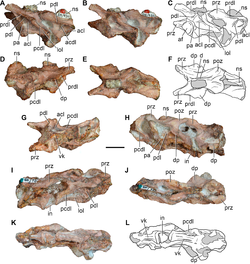Eorasaurus
| Eorasaurus | |
|---|---|

| |
| Cervical vertebrae of specimens PIN 156/108 (H-L) and PIN 156/109 (A-G) | |
| Scientific classification | |
| Domain: | Eukaryota |
| Kingdom: | Animalia |
| Phylum: | Chordata |
| Class: | Reptilia |
| Clade: | Archosauromorpha |
| Genus: | †Eorasaurus Sennikov, 1997 |
| Type species | |
| †Eorasaurus olsoni Sennikov, 1997
| |
Eorasaurus is an
Discovery
Eorasaurus was named by Andrey G. Sennikov in 1997. It is known from four specimens representing a single individual, PIN 156/108 through PIN 156/111. These four specimens were discovered in the 1930s near the Volga River in Tatarstan, Russia. They consist of nine vertebrae as well as one dorsal rib and two limb bones. Two cervicals (neck vertebrae), were termed specimen PIN 156/109 and designated as the holotype. Specimen PIN 156/108 represents three cervicals from the base of the neck, PIN 156/110 represents a rib and four dorsals (back vertebrae) near the neck, while PIN 156/111 is a pair of long bones and other fragments possibly from a limb. The material was collected from the Semin Ovrag locality of the upper Severodvinian Horizon (also known as the North Dvina Gorizont) in the Volga River Basin.
Description

The body or
A combination of features in the vertebrae of Eorasaurus distinguish it from other reptiles. The main rib facets (diapophyses) are connected to other parts of the vertebrae via bony ridges called prezygodiapophyseal and centrodiapophyseal laminae. Laminae are characteristic of archosauromorph vertebrae, along with an irregular polygon-like shape of the cervicals. One autapomorphy (unique derived characteristic) of Eorasaurus is the presence of an additional lamina that splits off from the underside of the centrodiapophyseal lamina and crosses the centrodiapophyseal fossa, a deep pit which lies in front of the centrodriapophyseal lamina.[2]
Classification
Based on the structure of its vertebrae, Eorasaurus is almost certainly a member of a
However, when Ezcurra et al. (2014) included Eorasaurus olsoni for the first time in a
Eorasaurus was also utilized in Ezcurra (2016)'s phylogenetic analysis. It was one of several unstable "proterosuchian"-grade taxa which formed a polytomy at the base of Archosauriformes. This polytomy was resolved only after the removal of Eorasaurus and its fellow wildcard taxa from the analysis.[3]
Below is a cladogram from Ezcurra et al. (2014) showing their interpretation of Eorasaurus as an archosauriform:
| Diapsida
|
| ||||||||||||||||||||||||||||||||||||||||||||||||
References
- ^ a b Sennikov, Andrey G. (1997). "An enigmatic reptile from the Upper Permian of the Volga River Basin". Paleontologicheskii Zhurnal. 31 (1): 94–101.
- ^ PMID 24586565.
- ^ PMID 27162705.
